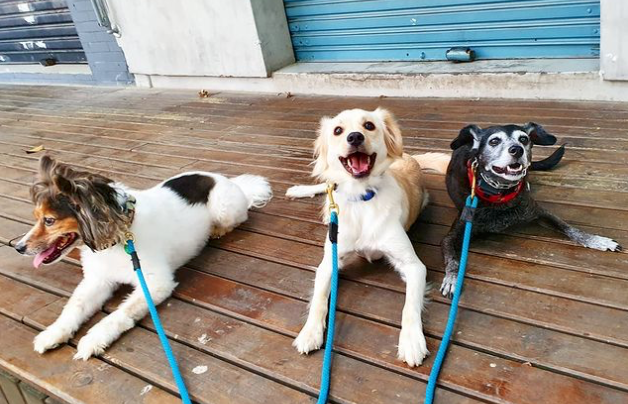
Warning: The New Dog Mental Health Fallacy and the Real Danger of Medication
A growing trend claims dogs suffer from human-like mental disorders such as anxiety and depression. This article explains why that narrative is dangerous, how medication replaces responsibility, and why training—not drugs—is the real solution for canine behavior.

Full-Time RV Travel With Dogs: Practical Safety Tips for Large Breeds on the Road
Full-time RV travel with dogs requires more than good intentions—it requires structure, preparation, and real-world experience. This article shares practical, experience-based strategies for traveling safely with large breeds like German Shepherds and Rottweilers while navigating campgrounds, public perception, and life on the road across Texas and the U.S.

Why Transparency Is the Foundation of Ethical Dog Training in Rockwall & Sachse, Texas
Transparent documentation is the foundation of ethical dog training. Instead of selling illusions or hiding key parts of the process, we show every step of a dog’s progression so owners in Rockwall and Sachse, Texas can make informed, confident decisions. Real training, real methods, real results.

Responsibility, Training, and Inclusion: Lessons from a Dog Bite Incident at a Mall
Dog bite incidents in public spaces highlight the urgent need for responsible dog ownership, child supervision, and respect for shared environments. At Flip Flop Dog Trainer, we emphasize training, education, and social etiquette to create safer, inclusive spaces where dogs and people coexist harmoniously.

Why You Should Be Ultra Selective When Choosing a Dog Trainer, Dog Walker, or Pet Sitter?
In the world of dog training and pet care, you’re not just paying for time—you’re investing in trust, experience, and a better future for your dog. The right trainer isn’t always the cheapest one, but they’ll always be the one who puts your dog’s well-being first.

When Responsibility Dies: A Wake-Up Call from a Heartbreaking Airport Incident.
If you’re reading this and you’re a dog owner, or thinking of becoming one, I beg you: Don’t take the easy way out. Train with intention. Live with integrity. Know that your dog’s behavior is, in part, a reflection of the relationship you’ve built. This incident at the airport wasn’t just a failure of one individual. It was a failure of all the values we need to hold sacred: compassion, responsibility, empathy. Let it serve as a wake-up call.

Generational Differences in Motivation and the Impact of the Internet: What It Teaches Us About Training Dogs.
When we over-accommodate our dogs — giving them constant treats, zero boundaries, or trying to shield them from every little frustration — we unintentionally create anxious, insecure, or even disobedient dogs. Why? Because they never develop the ability to handle pressure, effort, or even a bit of frustration. A dog that’s never been asked to work for a reward, face new environments, or overcome small obstacles is like a human raised in total emotional comfort — they lack resilience, patience, and motivation to learn.

Critical Thinking in Dog Training Choices.
The only solid proof of a trainer’s skill is seeing their work in action. That’s why, at The Flip Flop Dog Training, we make it a priority to share videos of our training sessions and real results with real dogs. When you watch a trainer working with a variety of dogs, dealing with real-life behavior challenges, you’re able to see the methods, the results, and the kind of relationship they build with the dogs.

Why Board and Train Works Best in a Home Setting – The Flip Flop Dog Training Difference?
When it comes to helping your dog become the best version of itself, where and how that transformation happens matters. At The Flip Flop Dog Training, we believe that board and train programs are most effective when they take place in a home setting — not in a loud, overcrowded facility. Why? Because dogs, like people, learn best in real-world environments, where the lessons taught are immediately applicable to their daily lives.

Unlocking the Power of Social Experiences for Dogs: Building Confidence and Enhancing Urban Living
By embracing social experiences and providing guidance through training, dog ownership becomes a truly powerful and amazing experience. It's not just about having a pet; it's about embarking on a journey of growth, learning, and companionship together. Each new social experience strengthens the bond between dog and owner and enriches both lives in profound ways.

Conquer Separation Anxiety: Empowering Your Beloved Dog to Thrive
Separation anxiety in dogs is not merely a behavioral quirk; it's a distressing emotional state that can have a profound impact on your beloved dog's well-being. But fret not! Understanding this condition is the first step toward helping your beloved companion cope better when you're away.

Unleashing the Power of Properly Trained Service Dogs: Ensuring Safety and Support in Public Spaces
Certification is not a mere formality; it's the cornerstone of trust and reliability. Organizations like Assistance Dogs International (ADI) and the International Association of Assistance Dog Partners (IAADP) set stringent standards, ensuring that service dogs are not just companions but highly skilled assistants. Handlers, too, must demonstrate genuine need and commit to ongoing training to maintain certification.

Balancing Act: Navigating Mental Health Challenges While Caring for Your Canine Companion
Living with mental health issues can present profound challenges, often extending beyond the individual to affect their closest companions, including their beloved canine companions. It's essential to approach this topic with empathy, acknowledging the complexities and struggles faced by those grappling with conditions such as depression, anxiety, or PTSD. These individuals may find themselves engulfed in a relentless battle against their own minds, grappling with feelings of despair, fatigue, and emotional turmoil. In the midst of this internal turmoil, the responsibility of caring for a dog can become an overwhelming burden, magnifying the already daunting task of managing their own well-being.

Enhancing Canine Behavior with the "Place" Command: A Comprehensive Guide to Balanced Training
One invaluable tool in this arsenal is the "Place" command. By teaching dogs to go to a designated spot and remain there until released, owners can effectively manage their behavior both indoors and outdoors. This guide explores the multifaceted benefits of the "Place" command and how it contributes to a well-rounded training regimen.

Summer Safety for Dogs: Essential Tips to Keep Your Dogs Cool and Healthy.
When it comes to water activities, swimming can offer a refreshing respite from the summer heat for both pets and their owners. However, it's essential to exercise caution and supervision to ensure a safe experience. Not all pets are natural swimmers, and some may require assistance or training to feel comfortable in the water. Additionally, owners should be mindful of potential hazards, such as strong currents or submerged obstacles, and choose designated dog-friendly swimming areas whenever possible.

Unleashing the Benefits of Raw Feeding: A Comprehensive Guide to Canine Health and Wellness.
Advocates of this approach argue that it offers numerous benefits for canine health and well-being by providing a diet rich in whole foods in their natural state. Raw diets typically include raw muscle meat, bones, organs, and certain vegetables and fruits, all of which are free from artificial additives, fillers, and preservatives commonly found in commercial dog foods. By eschewing the cooking process, raw feeding aims to preserve the natural enzymes, vitamins, minerals, and other nutrients present in raw ingredients, which proponents believe are essential for optimal health.

The Benefits of Crate Training for Dogs: Ensuring Safety and Security
Crate training is a highly effective method for dog owners to provide structure, safety, and security for their canine companions. While some may initially perceive crates as cages or confinement, when utilized properly, crates can serve as a den-like environment where dogs feel safe and comfortable. Here are several benefits of crate training for both dogs and their owners:

Breaking Free from the Shackles of Low Expectations in Dog Training: A Journey to Empowerment
In modern day society we’ve been conditioned to accept very little, in every aspect of our lives. When it comes to dog training and dog behavior, we are no different. Low expectations will always set us up for failure and unfortunately our dogs will become a big part of that frustration. Because we are constantly being bombarded with information that discourages us from expecting more, we tend to get less and less but living with that, years on end, can be consuming, frustrating and deeply disappointing.

Emotions in dogs: why it became such a hot topic and what’s really behind that narrative?
It is crucial to be aware of that narrative because it is not only present in the dog training world, but also everywhere. The modern-day generation is being taught to accept just about anything that comes with an emotional justification, for their own detriment. Dogs are just a by product of that and we are here to make sure people don’t fall for that trap.

Resource guarding in dogs: why it is simple to fix but nobody wants to do it?
Remember, resources are not just objects or food. Resources can also be spaces and people, so the crate is also another crucial piece of the puzzle when it comes to stopping resource guarding. Most dogs are not created often and that means they have plenty of time and freedom to explore and claim new resources. We are not always able to supervise and interact with our dogs so when we are busy or unable to pay close attention to them, they may find a way to explore new possibilities.


